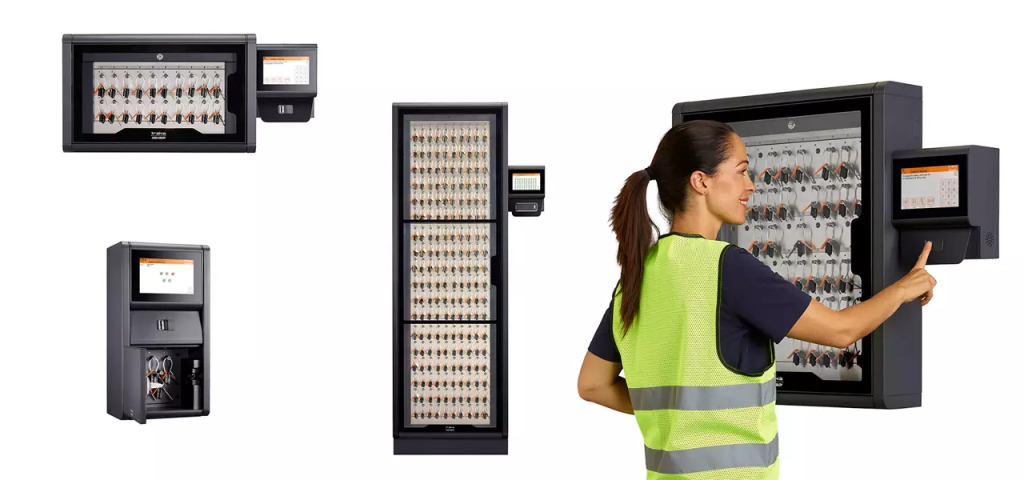
In an era where operational risk and asset loss carry real cost, businesses need technology that reduces human error while improving auditability. An electronic key management system replaces outdated metal key racks and manual sign-out logs with automated, auditable controls designed for modern teams. For facilities that value security, uptime and compliance, an electronic key management system is a practical investment.
How an Electronic Key Management System Works
An electronic key management system combines secure hardware (smart cabinets or lockers), multi-factor user authentication and cloud-connected software to control who can access each key. Administrators set access policies, trigger alerts for overdue keys, and generate compliance reports from a central dashboard. Modern electronic key management system vendors also provide mobile check-out, role-based permissions, and integrations with HR and maintenance systems.
Top commercial benefits for buyers
- Reduced loss and shrinkage: automated tracking lowers the chance of misplaced keys and the operational cost of rekeying.
- Clear chain-of-custody: detailed logs show who used which key and when — valuable for liability and audits.
- Scalable access control: electronic key management system scale from single offices to multi-site deployments without complex manual processes.
Integration-Ready Operations
Integration-ready systems connect to building management, scheduling and dispatch systems so key custody fits existing workflows. When physical access events are tied into operational tools, maintenance and dispatch teams execute faster and with fewer errors.
What To Look For when choosing Key Management Solutions

While different vendors emphasize hardware, software or integrations, buyers should compare authentication methods, audit depth, cloud vs on-premise options, and support for mobile workflows. The best key management solutions balance strong physical security with intuitive software that frontline staff will actually use.
Industry Use-Cases With Commercial Outcomes
- Property management: reduce lock changes and tenant turnover costs by tracking access and assigning temporary permissions.
- Fleet operations: speed vehicle dispatch and reduce downtime by centralizing key issuance and scheduling.
- Healthcare and education: meet compliance and chain-of-custody requirements with timestamped records and role-based access. Implementation of an electronic key management system in these sectors often shows clear cost and operational improvements.
Implementation Checklist for Procurement Teams
- Define access policies and user roles before selecting hardware.
- Pilot with a single site and measure reduction in lost-key incidents.
- Ensure the vendor provides training, SLA-backed support and clear data export options. Ask about integration with existing access control — a mature electronic key management system will offer REST APIs or SSO to simplify rollout.
Why choose Keysystem.ai
At keysystem.ai we design electronic key management system and services that prioritize uptime, reporting and seamless integrations. Our consulting-led approach helps you pick the right cabinet size, authentication method and reporting cadence. We implement with minimal disruption so your teams can keep working while protection improves.
Commercial ROI and Measurement
Measure reductions in rekeying costs, average time to assign a key, and loss incidents before and after deployment. Organizations that adopt an electronic key management system report measurable declines in replacement key spend and faster response times for on-site services.
Selecting Between on-premise and cloud deployments
Cloud offerings simplify updates, centralize logs and support remote administration, while on-premise electronic key management system may appeal to organizations with strict data residency or air-gapped requirements. Consider hybrid deployments when you need local cabinet resilience with cloud analytics.
Vendor features checklist
Look for: authentication options (PIN, RFID, biometric), tamper-resistant cabinets, role-based access, automated overdue alerts, detailed reporting, and integration APIs. Also evaluate installation, training, warranty and local support for sustained performance.
Comparing physical cabinets, smart lockers and software-first approaches
Physical cabinets remain the backbone for organizations that need tangible custody of metal keys. Smart lockers add modularity for high-volume use cases while software-first approaches focus on scaling permissions across digital and physical keys. Choose a solution that aligns with your operational model rather than the vendor’s marketing pitch. Industry reviews show that remote administration and reporting are decisive factors in long-term satisfaction.
Commercial case study snapshot
A mid-sized property management company reduced annual rekeying and replacement costs by shifting from manual key boxes to an automated cabinet with role-based access, audit logs and scheduled check-outs. Beyond direct savings, staff time reclaimed from tracking and reconciling keys created measurable productivity gains for on-site maintenance teams. This pattern repeats across sectors: when physical access is treated as a managed service, operational overhead drops and accountability rises.
Pricing models and what they mean for buyers
Vendors typically offer a hardware purchase or lease, plus recurring software subscriptions and optional installation services. Understand total cost of ownership by factoring installation, training, warranty, and cloud storage fees into multi-year ROI projections. Subscription models can accelerate deployment for organizations unwilling to make a large upfront capital expense, while purchase options sometimes reduce long-term operating costs.
Frequently asked procurement questions
Q — How long does a rollout take? Small sites can be operational in days; multi-site rollouts are phased over weeks depending on complexity and integrations.
Q — Is integration hard? Mature providers expose APIs and connectors for access control and HR systems, which shortens integration timelines.
Q — What about compliance? Audit logs, time-stamped transactions and tamper alerts help demonstrate chain of custody for regulatory and insurance requirements.
How to select vendors and secure ongoing value
When evaluating providers, prioritize vendors that combine dependable local support with a transparent roadmap for software updates. Ask for sector-specific references, request a live demo that exercises APIs and reporting, and insist on a clear onboarding plan with administrator and end-user training. Confirm SLA terms for hardware replacement and software uptime, and verify that data export and backup options meet procurement rules. Consider total lifecycle costs and include integration tests in the pilot.
Support and training are often the differentiators: ensure the vendor provides at least 12 months of dedicated support and periodic performance reviews. This diligence keeps the solution an operational asset rather than a sunk cost.
Begin with a single-site pilot, measure rekeying and downtime savings, then scale across sites once KPIs show clear operational and financial improvements and report results to stakeholders.
Get a free sales enquiry or demo today and see how Electronics Key System Manager can help you achieve real results.
Keysystem.ai
Email: sales@keysystem.ai
Call: 00447944834433
WhatsApp: https://wa.me/00447944834433
Visit: https://keysystem.ai/
AI Intelligent Electronic Key Management System
#ElectronicKeyManagementSystem #KeyManagementSystem #UKSecuritySolutions #KeyControl #UKSecuritySystems #SmartLockers #KeyManagement #SecureKeys #SecureAccess #AssetManagement